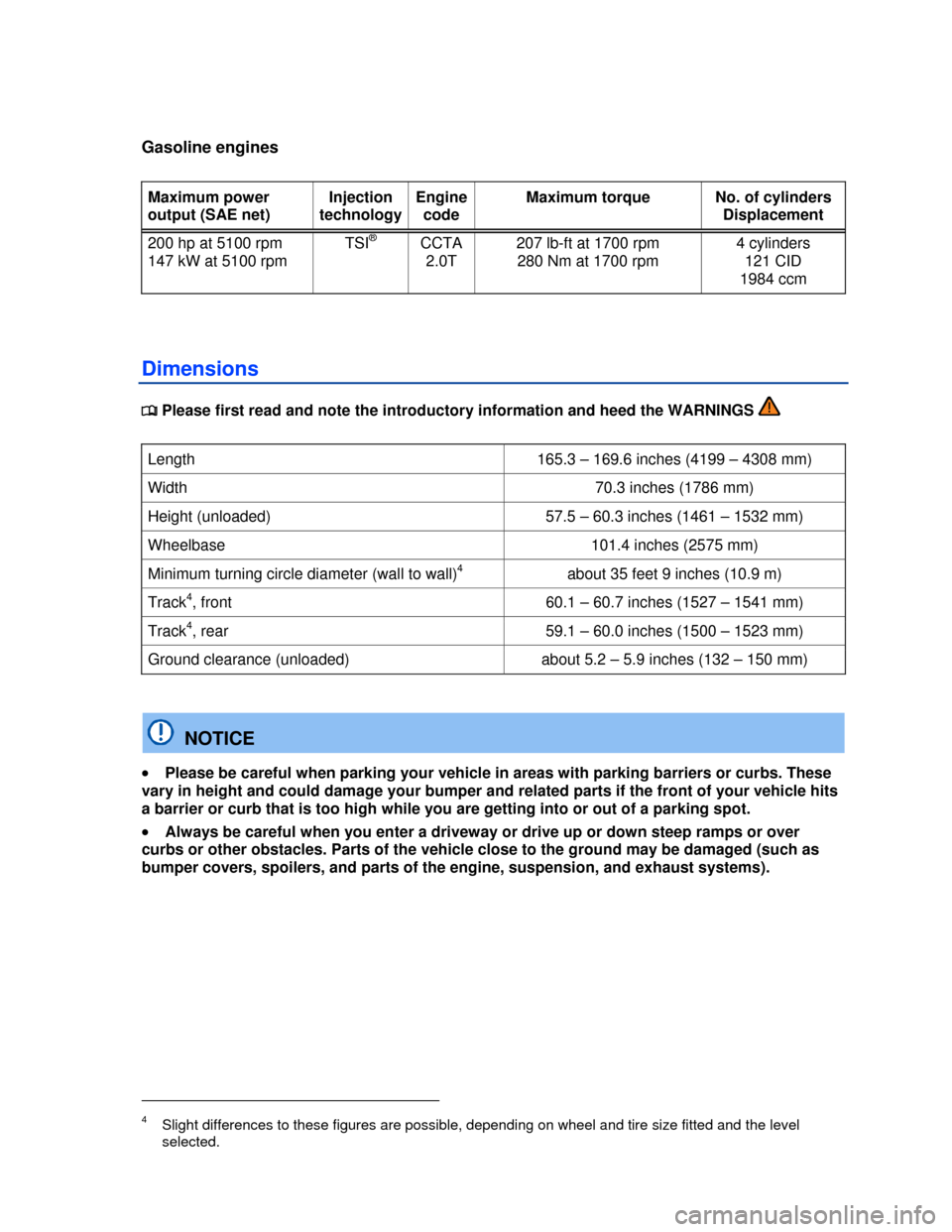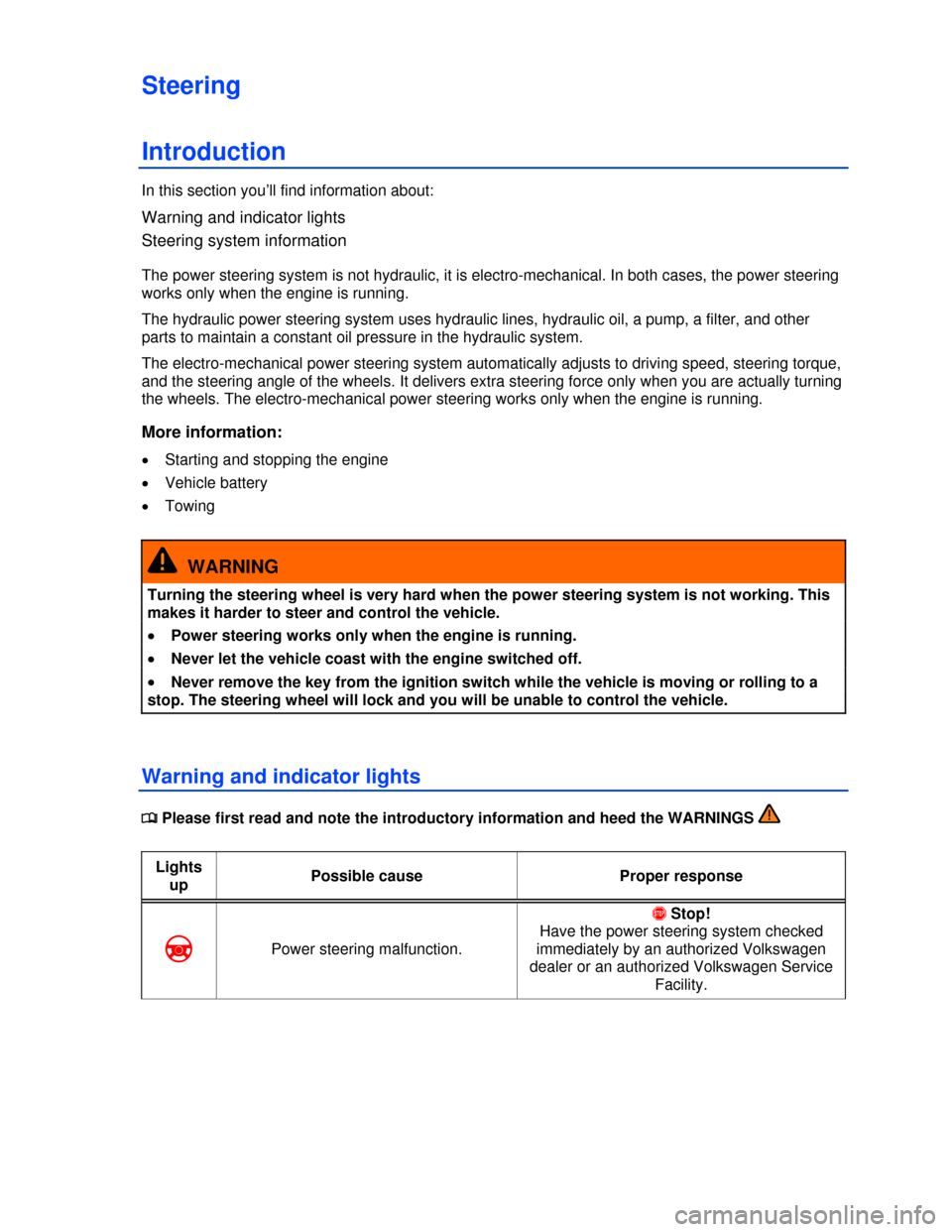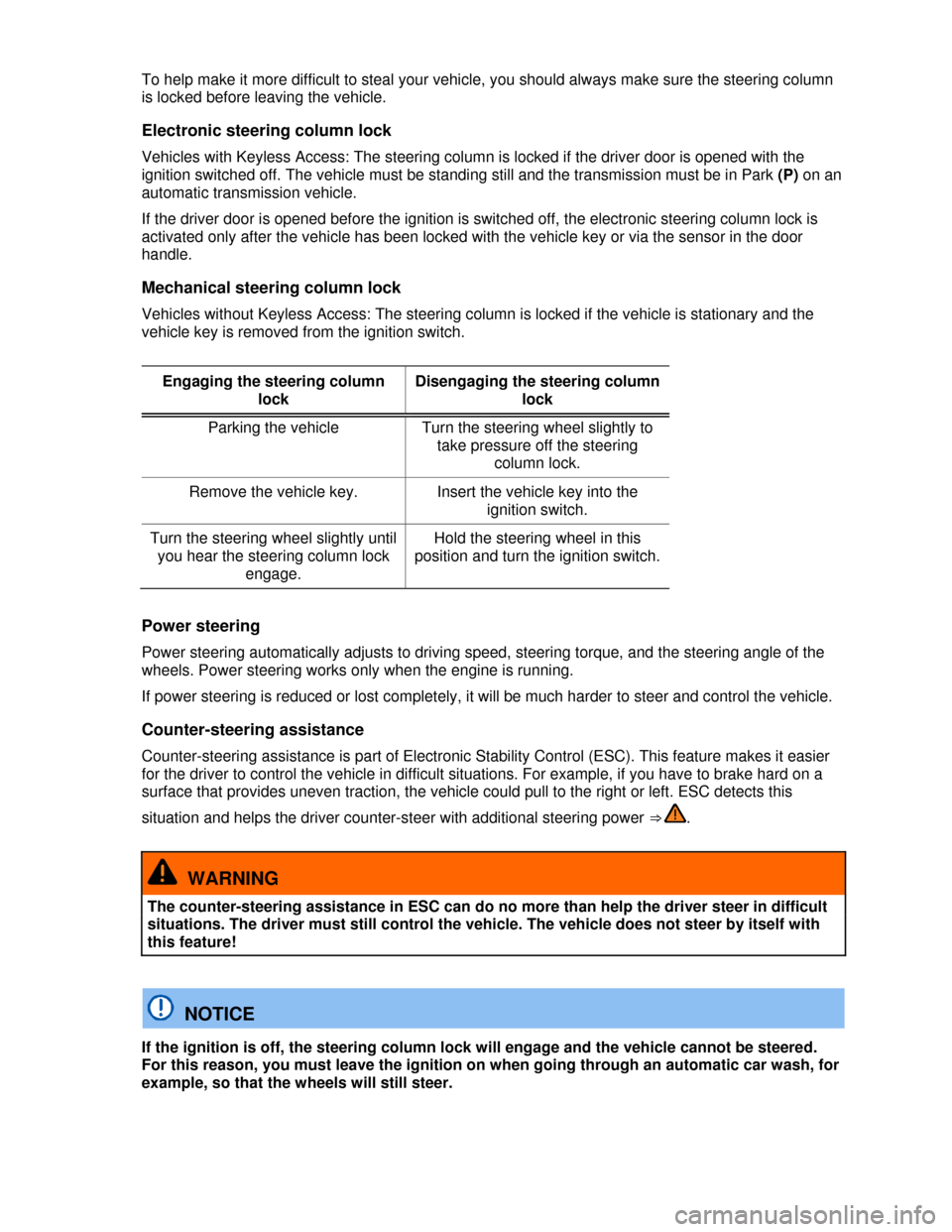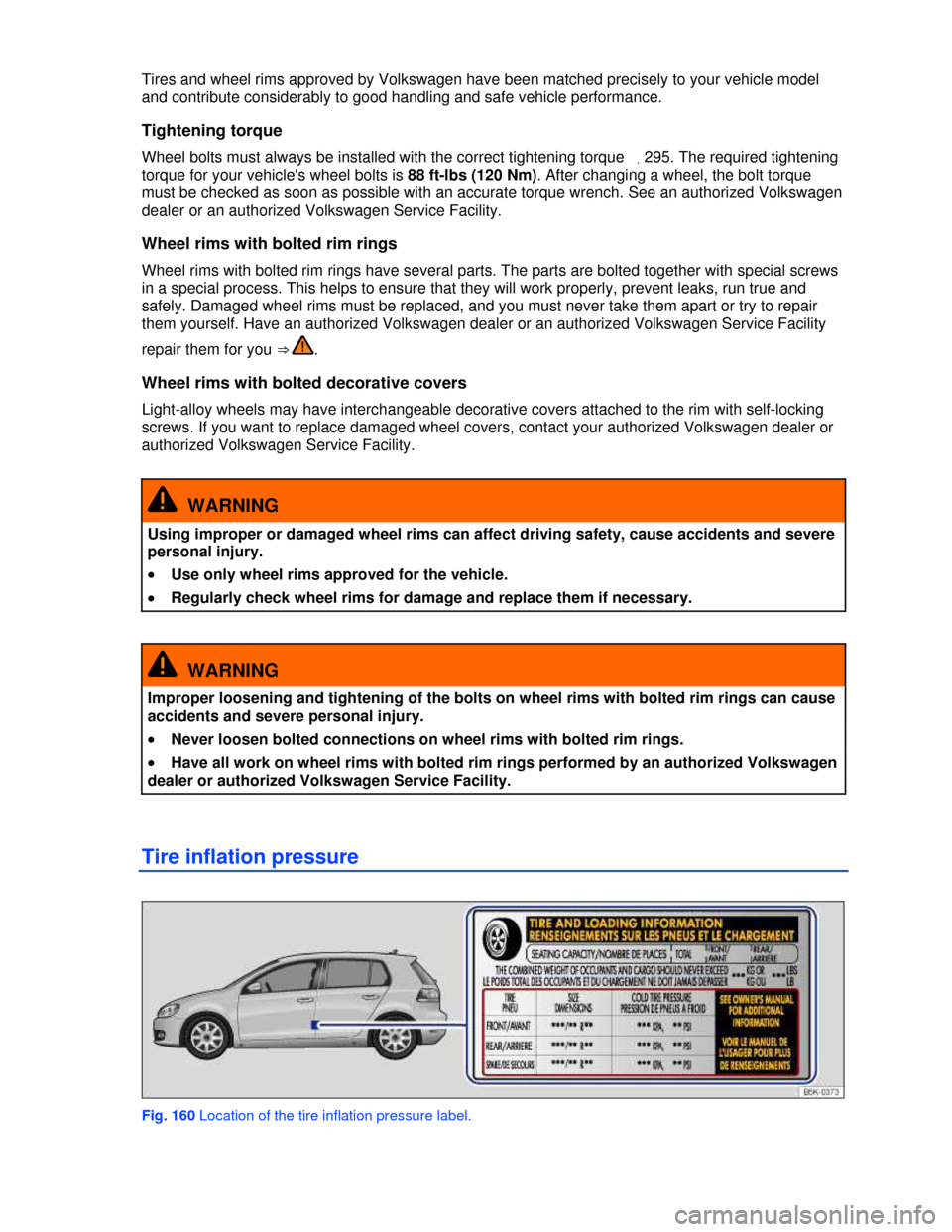2013 VOLKSWAGEN GOLF GTI torque
[x] Cancel search: torquePage 32 of 319

Gasoline engines
Maximum power
output (SAE net)
Injection
technology
Engine
code
Maximum torque No. of cylinders
Displacement
200 hp at 5100 rpm
147 kW at 5100 rpm
TSI® CCTA
2.0T
207 lb-ft at 1700 rpm
280 Nm at 1700 rpm
4 cylinders
121 CID
1984 ccm
Dimensions
�
Page 191 of 319

Steering
Introduction
In this section you’ll find information about:
Warning and indicator lights
Steering system information
The power steering system is not hydraulic, it is electro-mechanical. In both cases, the power steering
works only when the engine is running.
The hydraulic power steering system uses hydraulic lines, hydraulic oil, a pump, a filter, and other
parts to maintain a constant oil pressure in the hydraulic system.
The electro-mechanical power steering system automatically adjusts to driving speed, steering torque,
and the steering angle of the wheels. It delivers extra steering force only when you are actually turning
the wheels. The electro-mechanical power steering works only when the engine is running.
More information:
�x Starting and stopping the engine
�x Vehicle battery
�x Towing
WARNING
Turning the steering wheel is very hard when the power steering system is not working. This
makes it harder to steer and control the vehicle.
�x Power steering works only when the engine is running.
�x Never let the vehicle coast with the engine switched off.
�x Never remove the key from the ignition switch while the vehicle is moving or rolling to a
stop. The steering wheel will lock and you will be unable to control the vehicle.
Warning and indicator lights
�
Page 193 of 319

To help make it more difficult to steal your vehicle, you should always make sure the steering column
is locked before leaving the vehicle.
Electronic steering column lock
Vehicles with Keyless Access: The steering column is locked if the driver door is opened with the
ignition switched off. The vehicle must be standing still and the transmission must be in Park (P) on an
automatic transmission vehicle.
If the driver door is opened before the ignition is switched off, the electronic steering column lock is
activated only after the vehicle has been locked with the vehicle key or via the sensor in the door
handle.
Mechanical steering column lock
Vehicles without Keyless Access: The steering column is locked if the vehicle is stationary and the
vehicle key is removed from the ignition switch.
Engaging the steering column
lock
Disengaging the steering column
lock
Parking the vehicle Turn the steering wheel slightly to
take pressure off the steering
column lock.
Remove the vehicle key. Insert the vehicle key into the
ignition switch.
Turn the steering wheel slightly until
you hear the steering column lock
engage.
Hold the steering wheel in this
position and turn the ignition switch.
Power steering
Power steering automatically adjusts to driving speed, steering torque, and the steering angle of the
wheels. Power steering works only when the engine is running.
If power steering is reduced or lost completely, it will be much harder to steer and control the vehicle.
Counter-steering assistance
Counter-steering assistance is part of Electronic Stability Control (ESC). This feature makes it easier
for the driver to control the vehicle in difficult situations. For example, if you have to brake hard on a
surface that provides uneven traction, the vehicle could pull to the right or left. ESC detects this
situation and helps the driver counter-steer with additional steering power ⇒ .
WARNING
The counter-steering assistance in ESC can do no more than help the driver steer in difficult
situations. The driver must still control the vehicle. The vehicle does not steer by itself with
this feature!
NOTICE
If the ignition is off, the steering column lock will engage and the vehicle cannot be steered.
For this reason, you must leave the ignition on when going through an automatic car wash, for
example, so that the wheels will still steer.
Page 251 of 319

Tires and wheel rims approved by Volkswagen have been matched precisely to your vehicle model
and contribute considerably to good handling and safe vehicle performance.
Tightening torque
Wheel bolts must always be installed with the correct tightening torque .295. The required tightening
torque for your vehicle's wheel bolts is 88 ft-lbs (120 Nm). After changing a wheel, the bolt torque
must be checked as soon as possible with an accurate torque wrench. See an authorized Volkswagen
dealer or an authorized Volkswagen Service Facility.
Wheel rims with bolted rim rings
Wheel rims with bolted rim rings have several parts. The parts are bolted together with special screws
in a special process. This helps to ensure that they will work properly, prevent leaks, run true and
safely. Damaged wheel rims must be replaced, and you must never take them apart or try to repair
them yourself. Have an authorized Volkswagen dealer or an authorized Volkswagen Service Facility
repair them for you ⇒ .
Wheel rims with bolted decorative covers
Light-alloy wheels may have interchangeable decorative covers attached to the rim with self-locking
screws. If you want to replace damaged wheel covers, contact your authorized Volkswagen dealer or
authorized Volkswagen Service Facility.
WARNING
Using improper or damaged wheel rims can affect driving safety, cause accidents and severe
personal injury.
�x Use only wheel rims approved for the vehicle.
�x Regularly check wheel rims for damage and replace them if necessary.
WARNING
Improper loosening and tightening of the bolts on wheel rims with bolted rim rings can cause
accidents and severe personal injury.
�x Never loosen bolted connections on wheel rims with bolted rim rings.
�x Have all work on wheel rims with bolted rim rings performed by an authorized Volkswagen
dealer or authorized Volkswagen Service Facility.
Tire inflation pressure
Fig. 160 Location of the tire inflation pressure label.
Page 302 of 319

WARNING
Changing a wheel, especially on the side of the road, can be dangerous. To help reduce the
risk of serious personal injury:
�x Always stop the vehicle as soon as it is safe to do so. Move the vehicle a safe distance off
the road where it is safe to change the wheel.
�x Always make sure that all passengers, especially children, are in a safe place outside the
vehicle and away from the vehicle and traffic (such as behind a guard rail).
�x Turn on the emergency flashers and set up another warning device about 25 yards
(25 meters) behind the vehicle to warn approaching traffic.
�x Change a wheel by yourself only if you are familiar with the necessary steps. Otherwise,
get expert assistance.
�x Always switch the engine off, firmly apply the parking brake, and shift the transmission
into Park (P) (automatic transmission) or any gear (manual only) to help prevent the vehicle
from moving suddenly and slipping off the jack.
�x Always make sure that the ground is level and firm. If necessary, place the jack on a large
and sturdy board or on a similar ground support.
�x Always block the wheel diagonally opposite the wheel being changed with chocks or other
similar things.
�x If you are towing a trailer, always unhitch it from your vehicle before starting to change
the wheel. Always apply the trailer brakes firmly and make sure the trailer cannot move
unintentionally.
�x Always use proper and undamaged tools when changing a wheel.
�x Once a wheel is lifted off the ground, having the transmission in Park (P) or in gear will not
prevent sudden vehicle movement.
�x Always use a jack that has been approved by the manufacturer for your vehicle. Never use
other jacks, even if they have been approved for use on other Volkswagen models.
�x To reduce the risk of losing control, crashes, and serious personal injuries, never loosen
the screws on rims with threaded rim rings.
�x After changing a wheel, have the wheel bolt tightening torque checked with an accurate
torque wrench.
�x After changing a wheel or tire, reset the Tire Pressure Monitoring System .Error!
Bookmark not defined..